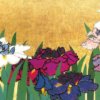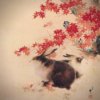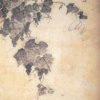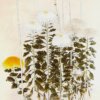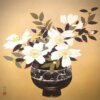Mori Kansai: The Last Mori School Star Painter Who Was Called “the Meiji Period’s Maruyama Ōkyo”
Kantei (Garden the Cold)
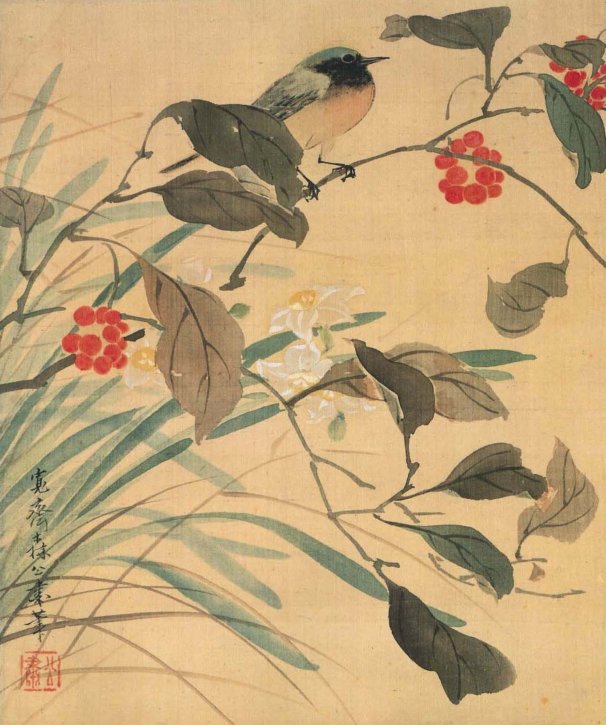
Mori Kansai was born in Yamaguchi Prefecture in 1814. He loved painting from an early age and he first learned under a man named Ōta Ryū. Then, around the age of 18, left for Ōsaka, following Toda Kurōzaemon, and became a disciple of Mori Tetsuzan. However, less than a year later, Toda became ill, so Kansai returned home with Toda. After that, after several years of traveling to nearby countries, he went out to Ōsaka again at the age of 25 and became a disciple of Tetsuzan again. After that, Kansai succeeded Mori’s surname from his master, Tetsuzan, and went to Kyōto to revive the declining Maruyama school. At one point, he stayed at Tetsuzan’s child Tanaka Kuranojō’s place, who was a Buddhist image maker in Kyōto’s Horikawa Bussho (Buddist temple). He worked hard to revive the declining Maruyama School in Kyōto.
In this work, entitled “Kantei (Garden in the Cold)”, a small bird perched on red fruit twigs and daffodils are drawn with a light brushstroke with a Tsuketate technique (a Japanese painting technique seen in Maruyama and Shijō school. Without using contours, painters drew with a brush containing two types of ink or paint at the same time to create a shade or three-dimensional effect.) It is a refreshing work that captures the scene of a corner of the garden in the cold with skillful composition and brush strokes.
Kachō-Zu (Flowers & Birds Painting)
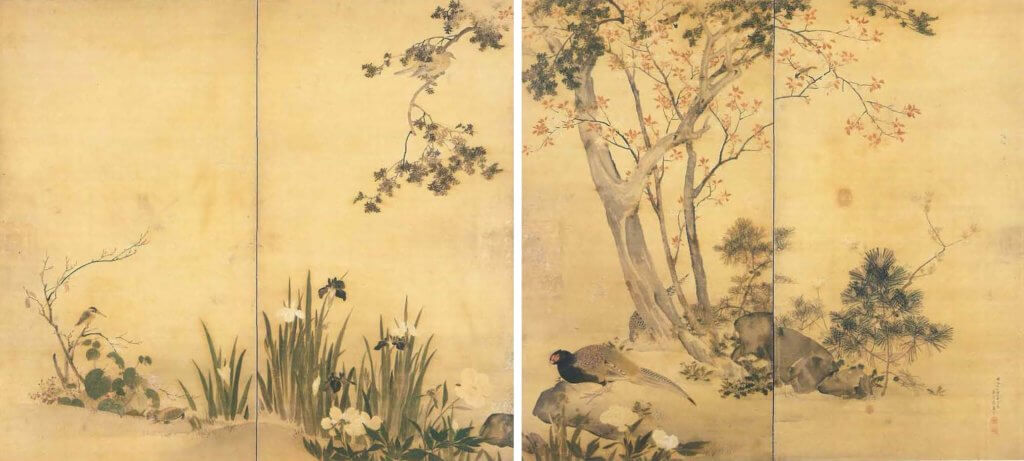
Although Kansai, who went to Kyōto, was a painter, he worked as a man of Chōshū and worked on national affairs during the turbulent period at the end of the Tokugawa shogunate. It seems that he often went back and forth between Kyōto and Hagi and sometimes he got in danger doing that. From his youth to the end of the Tokugawa shogunate, he struggled with his living and life, but it can be said that the days had been relatively smooth since the beginning of the Meiji period. As a landlord of the Meiji period, together with Kishi Chikudō, Shiokawa Bunrin, and Kōno Bairei, he lived in the transitional period from the end of the Edo period to the Meiji period and passed the tradition on to the next generation of Kyōto painters. Gradually, his position as the Kyōto painter became higher, and he became the centerpiece of Jounsha after Shiokawa Bunrin’s death. He served at the Kyōto-fu Gagakkō (Kyōto Prefectural School of Painting) when it opened in 1880, he won the Myōgi Nitōshō prize for the second Naikoku Kangyō Hakurankai exhibition in 1881 and also won the silver seal at the first Naikoku Kaiga Kyōshinkai exhibition in 1882. After that, he continued to actively produce paintings and left many works, but died in 1894 at the age of 81.
This work is a Byōbu with two folded screen, but there are traces of pulling on each side, and it had been cleared that it was originally a four-sided sliding door. On the shore of the pond at the base of the cherry blossoms and cypress, irises and rose summer grass are drawn, and male and female pheasants, a pigeon, a kingfisher, and a turtle are also drawn. Maybe, it was the figure of autumn and winter continuing to express the four seasons. In the depictions of rocks and trees, the characteristics of the Maruyama school are clearly shown. It was a work of Kansai at the age of 66 years old.
Shikisōka-no-Zu (Flowers of the Four Seasons Painting)
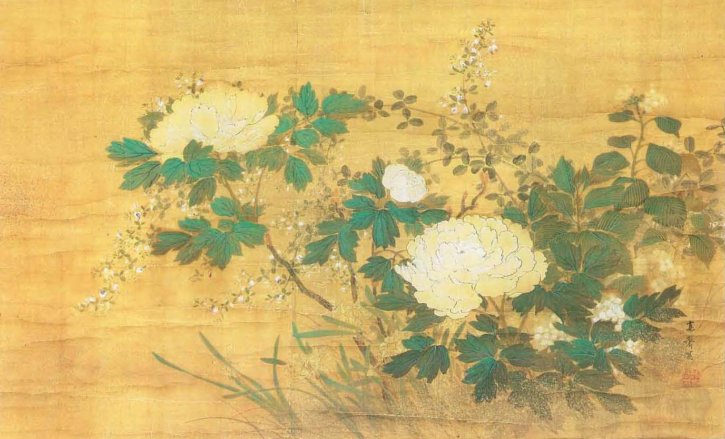
Mizuberyūtō-Z (Willow and Peach Trees near the Pond Painting) / Kōyōsōto-Zu (Autumn Leaves and 2 Rabbits Painting)
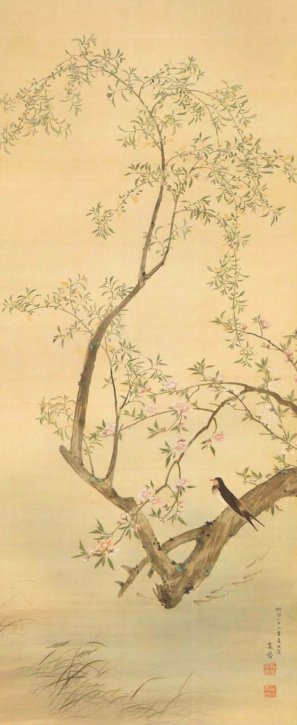
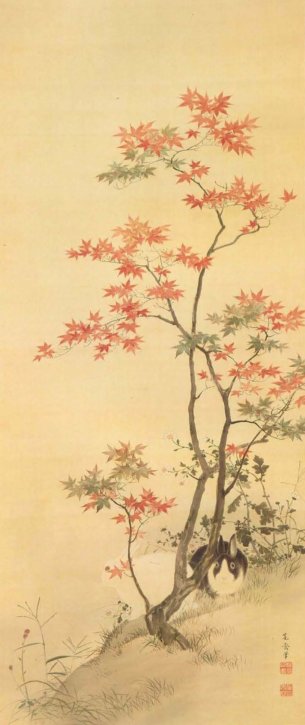
Kansai learned from Maruyama Ōkyo’s disciple, Mori Tetsuzan, and was allowed to name Mori’s surname. Mori Tetsuzan was the son of Mori Shūhō (the older brother of Mori Sosen) and succeeded the family from Sosen. Mori Shūhō, Mori Sosen, Mori Tetsuzan, etc. formed a painting school called the Mori school that was active in Ōsaka’s painting circle. Among them, Mori Sosen was a painter who emphasized sketching and opened up a new world of painting. He is an important presence in the modern sketching school together with Ōkyo. Tetsuzan was a painter who succeeded the painting after Sosen, but he became a disciple of Ōkyo and worked on sketching. It was Tetsuzan who learned the techniques of sketching from two people, Ōkyo and Sosen and formed a school. Kansai learned from Tetsuzan and worked on developing Maruyama school from the end of the Edo period to the Meiji period. Tetsuzan had two sons, but both of them were sent to be adopted and his disciple Mori Ippō was taken into the Mori family as the son-in-law, and he became the head of the family. Kansai, who was also his disciple, was given the surname of Mori too. Ippō, who was the older brother disciple, succeeded the Mori school in Ōsaka, and Kansai succeeded the Maruyama school in Kyōto. The Maruyama school at the end of the Tokugawa shogunate, after the death of the painters who were the direct disciple of Ōkyo, such as Komai Genki, Nagasawa Rosetsu, Watanabe Nangaku, Yoshimura Kōkei, Yamaguchi Soken, Oku Bunmei, Gessen, Hatta Koshū, etc., had no worthy successor. Moreover, when Nakajima Raishō died in 1871, there were no people in the Maruyama school, and it could be said that Kansai was the only one keeping the school alive. Even after Kansai, there were Maruyama school painters such as Yamamoto Shunkyo, his disciple, Nakajima Raishō’s disciple Kawabata Gyokushō, and Suzuki Hyakunen’s son Suzuki Shōnen and disciple Imao Keinen. However, on the other hand, the Shijō school produced big painters such as Yokoyama Seiki, Shiokawa Bunrin, Kōno Bairei, etc., and the Kyōto’s painting circle was completely occupied by the Shijō school by the time when Takeuchi Seihō was produced under Bairei. Even in the Shijō school, Takeuchi Seihō was a completely modern Japanese-style painter and was independent from the traditional Shijō school style paintings of the previous Shijō school painters. On the contrary, Kansai drew his works clearly in the Maruyama school painting style. Kansai died in 1894, and other masters of the Kyōto painters of the Meiji painting such as Suzuki Hyakunen, Kōno Bairei, Kishi Chikudō, etc. also died around the 30th year of the Meiji period. It was a period of change between old and new Kyōto painters, and after that, a new Kyōto painting circle was formed in the development of individuality as a modern Japanese painting. In that sense as well, Kansai existed as one of the last painters with a traditional style.
“Shikisōka-no-Zu (Flowers of the Four Seasons Painting)” depicts flowers such as bush clovers, daffodils, and patrinia scabiosaefolia, with a large horizontally long peony at the center. Each flower has a different season, and as the title suggests, the flowers of the four seasons are drawn in one painting. The flowers depicted on the silk with gold paint are drawn with the Tsuketate technique, and it does not have the firmness of the Maruyama school or Kansai, and has the softness. It is the world with the gorgeous flowers of four seasons. The careful composition of the painting shows that it was made when he was a little younger, and is considered to be a work before the Meiji period.
“Mizuberyūtō-Zu / Kōyōsōtō-Zu” represents spring and autumn. In the ” Mizuberyūtō-Zu (Willow and Peach Trees near the Pond Painting)”, a swallow rests on a willow branch overhanging the pond, and a small school of fish and two shrimps are swimming on the surface of the water. The color is added with the peach branches that are blooming along the willow branches. It is a warm world that captures the idyllic scenery of the pond in early spring. The painting has a strong composition of the Shijō school elements and incorporates emotional expressions, but the strength of the Maruyama school is seen in the depiction of the branches of willows and peaches and the composition of the branches with flowers and leaves. Maybe you could call it the strength of Kansai, a loyalist of the fallen era who struggled with national affairs during the turbulent period at the end of the Edo period, rather than the strength of the traditional style of the Maruyama school.
The ” Kōyōsōto-zu (Autumn Leaves and 2 Rabbits Painting)” is a scene of a corner of the autumn field that captures two rabbits standing under the small autumn colored leaves. Autumn grass such as wild chrysanthemum grows around the rabbit, and it is a work that cuts out the scenery from the great outdoors. This work is also filled with a Shijō school atmosphere, but you can feel the toughness of Kansai in the way of drawing the thin trunk of autumn leaves and the way of grasping the composition. This work was drawn in his late period at the age of 76 years old.

